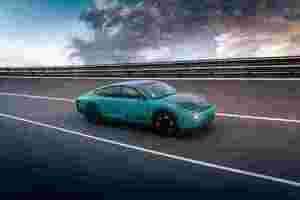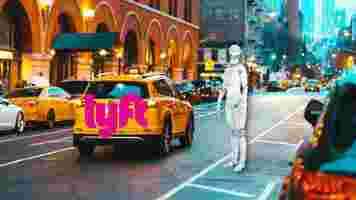What’s the difference between autonomous vehicles and driver-assistance tech?
Your new car is packed with a bunch of driver-assist features. But that doesn’t exactly make it an autonomous vehicle. So what’s the difference?

What is driver-assist?
Driver-assist is also called Advanced Driving Assistance Systems (ADAS). It refers to, and encompasses functions and technology that augment the driving experience of the driver. These include:
Blindspot detection.
Front, rear, and cross-traffic alerts.
Collision avoidance.
Lane departure warning.
Forward and side collision warning.
Adaptive cruise control.
Park assist.
For example, Volvo’s driver-assist functionality is called Volvo Pilot Assist and provides steering assistance to help the driver stay within lane markings on a road.
It provides audible, visible, and brake pulse warnings upon detecting cars, bikes, or pedestrians unexpectedly. If a collision is imminent, the car can brake automatically. It also helps maintain a set speed and the distance between your car and the vehicle ahead.
What is an autonomous vehicle?
An autonomous vehicle comes with technology to enable it to drive without any assistance from a human driver. It’s able to make decisions of its own volition and respond in real-time in response to the challenges of the road, such as oncoming traffic, turns, and traffic lights.
Tesla has a subscription feature called “Full Self-Driving” (or FSD). Despite a name that suggests otherwise, Tesla’s FSD is not self-driving but a driver-assist system. As you can see in the video below, Tesla still requires a lot of testing:
The company admitted last year in emails to the California DMV , that its subscription service is not self or autonomous driving.
To recap:


The five levels of vehicle automation
There are five levels to categories of vehicle automation, originally defined in 2018 , which have further evolved as the technology has advanced over the last few years .
Driver Assist programs typically fall under Level 2 meaning they require an alert driver able to take the wheel at all times.
Level 3 and 4 vehicle automation places limits on specific environments and conditions of vehicle automation .
For example, in December 2021, the German Federal Motor Transport Authority (KBA) granted Mercedes-Benz system approval of a Level 3 autonomation pilot to enable drivers to engage in activities like watching films while driving — applications that are otherwise blocked while driving under certain conditions. (It’s not publicly released yet).
L4 autonomous driving does not require human intervention, but the driver still has the option to manually override and take over control of the car.
By comparison, Level 5 is a car that is able to make decisions completely independently – the car is the driver. A driverless car can include no driver’s seat, steering wheel, gas pedal, or even brakes.
A small number of autonomous vehicles are commercially available — albeit in beta testing programs — for ride-hailing and delivering goods:
Waymo One
Google’s Waymo One became the first service provider to offer driverless taxi rides to the general public in a part of Phoenix, Arizona in 2020, with an expansion of the program to San Francisco .
People can hail the cars via smartphone, with travel restricted to certain areas within the city where the vehicles have been extensively tested.
Nuro
Nuro is the first-ever autonomous vehicle to receive an approved exemption from the National Highway Traffic Safety Administration. These exemptions remove the requirement for safety measures such as interior mirror, windshield, and backup camera requirements that are only designed to provide safety benefits for occupants — these are not necessary as the vehicle holds no occupants.
Nuro was the first company granted a commercial deployment permit by the State of California.
The company currently operates its delivery vehicles in Silicon Valley, Houston, and Greater Phoenix.
TuSimple
In late December, truck company TuSimple became the first business to achieve a successful fully- autonomous run by a class 8 vehicle, or semi , on open public roads with no human intervention. One of its semi-trailer trucks completed an 80-mile route in Arizona.
Vehicle technology is evolving rapidly, making it vital to have legal frameworks and industry standards. But in a competitive market, where automakers have promised vehicle automation for a long time, there are still a lot of challenges. Stay tuned as we dig into these in more detail.
The next big mobility innovation is solar electric cars — these 2 startups are leading the charge
A lot of people think car innovation begins and ends with Tesla. But Tesla was founded in 2003, almost 20 years ago.

Now, there’s a new breed of automaker startups advancing materials innovation and sustainable motoring. And they’re doing it using solar technology to make solar electric vehicles .
The two startups are Lightyear Motors and Sonos Motors. They both hail from Europe — from the Netherlands and Germany –and both started their journey in 2016. While most automakers seem stagnant in “nice to have” solar sunroofs, it’s these startups that are evolving the technology to new capabilities.
Lightyear Motors solar electric vehicles

Engineering student Lex Hoefsloot founded Lightyear in 2016 in the Netherlands. Currently, the solar car company employs more than two hundred employees.
Lightyear has raised over $100 million in funding.
In the summer of 2019, Lightyear launched its first driving prototype – Lightyear One. The Lightyear One drove for over 710 kilometers (440 miles) on a single battery charge in July. Pretty impressive, considering Lightyear One is still in prototype. Compare this to Lucid’s record-breaking 837 kilometers (520 miles) on a single charge , and you can see it will hold its own. This is just the beginning.
Today Sibros , a pioneer of deep Over-the-Air (OTA) connected vehicle technology, announced a collaboration with Lightyear.
Lightyear will integrate Sibros’ OTA Deep Logger to yield microsecond precision and real-world connected vehicle data from all sensors — both are vital to long-range solar and energy efficiency.
Sibros’ OTA Deep Updater will provide vehicle-wide software updates to the Lightyear One while meeting various safety and security requirements such as ISO 26262, GDPR, UNECE WP.29, and others. This is important, as compliance is hugely important in vehicle development and going to market. The Sibros platform will produce usage insights to augment future product design enhancements.
The company is building a $175,000 model and plans for a cheaper version down the line. An exclusive series of the Lightyear One will go into production in the summer of 2022, with plans to address the mass market starting from 2024/2025.
Sion solar electric vehicles
Sion is a solar electric vehicle in production by German company Sono Motors. The company was founded in 2016 and has over 200 employees. They’ve raised over $126 million in funding.
The Sono solar technology replaces traditional paint with proprietary integrated solar panels that can form to various applications. Unlike vehicles with rooftop solar panels alone, it comes with 248 solar cells on the hood, fenders, sides, roof, and rear.
Solar energy is made possible using monocrystalline silicon cells that produce energy even under cloudy skies or in the shade. While they appear somewhat delicate on the car, the company has committed to materials with a service life of at least eight years, resistance to environmental influences such as UV rays and water, break resistance and a low weight.
Usually, car makers laminate solar cells onto a 2 – 5 mm thick glass. However, glass has a comparatively high weight and only low break resistance. Sion, therefore, uses polymer as substrate material to make their solar electric vehicles. It is light, resistant, and significantly more break-proof than glass.
The Sion battery wallbox is a game-changer for bidirectional charging
What’s equally impressive is the Sion battery wallbox, which allows you to store excess energy from the PV system in the vehicle to supply your home later or be used to charge other cars.
Sono Motors signed a cooperation agreement for a large-scale vehicle-to-grid (V2G) project in Utrecht, Netherlands, with We Drive Solar. Sono Motors will provide 100 Sion solar electric vehicles, and thereby support the city to become the first metropolitan ecosystem to combine bidirectional charging and car-sharing.
Via integrated solar panels, all Sion will be charged using sustainable energy and will also be able to deliver excess energy back into the grid. The Sion’s discharging power of 11 kW combined with its battery helps to reduce grid instabilities and the likelihood of blackouts.
The Sion costs 28,500 euros, including German VAT. The company expects to start production in the first half of 2023. There’s over 15,000 reservations valued at $385 million. We can expect an IPO very soon.
— Update: 17/11/21: S ono announces the pricing of its initial public offering of 10,000,000 common shares to the public at a price of $15.00 per share. In addition, the Company has granted the underwriters a 30-day option to purchase up to an additional 1,500,000 common shares. The common shares are expected to begin trading on the Nasdaq Global Market today under the ticker symbol “SEV”.
So which company will triumph?
It’s tempting to pit the solar electric vehicles against each other. But I think what’s more important is that they show two things:
Firstly, innovation exists outside of traditional OEMs and longer-standing companies like Tesla and Lucid Motors.
Secondly, it shows a willing market of buyers. They want to buy into the next big thing in cartech.
And we know that it’s the market that drives success in automaking.
Lyft’s 2023 target for a driverless taxi launch looks overly-optimistic
Just because Uber has taken a step back from its self-driving taxi service, doesn’t mean others are following suit. Ride-hailing competitor Lyft has said that it plans to launch the first vehicles of its robotaxi fleet in 2023.

According to Engadget , Lyft has completed more than 100,000 safety-driver-equipped robotaxi journeys in Las Vegas, where it has been testing its fleet.
The ride-hailing company, which is developing driverless taxis in collaboration with self-driving car developers Motional, got the go ahead to test its fleet without drivers back in November. It plans to begin driverless tests in the coming months, with the hope that it can launch to the public in the next few years.
Lyft says that it will offer its self-driving taxi service in multiple cities across the US. However, it hasn’t said, or even hinted at, where. Lyft has said that it will take care of the ride-hailing side of things, whilst Motional will take care of managing the fleet of robotaxis.
Chances are that it will be in cities where driving conditions are highly controlled and predictable.
Russia’s Yandex is also developing self-driving cars, and has previously told SHIFT that its driverless taxis aren’t far from being launched in areas where it’s easy to predict how other drivers might react in certain situations. However, autonomous vehicles that work in the most complex scenarios are still five years away.
However, Uber recently threw doubt over whether driverless taxis will ever become A Thing when it sold its self-driving division to Aurora , a company that is primarily focused on building driverless trucks. Bear in mind, Uber has put $1 billion into developing self-driving cars — it is not a simple task.
Uber has retained a stake in Aurora and Uber‘s CEO, Dara Khosrowshahi, will sit on its board. So it’s not given up entirely, but it seems to indicate that robotaxis might be a more distant future than we have been told. With that in mind, Lyft‘s goal of 2023 still seems ambitious at best.
SHIFT is brought to you by Polestar. It’s time to accelerate the shift to sustainable mobility. That is why Polestar combines electric driving with cutting-edge design and thrilling performance. Find out how .